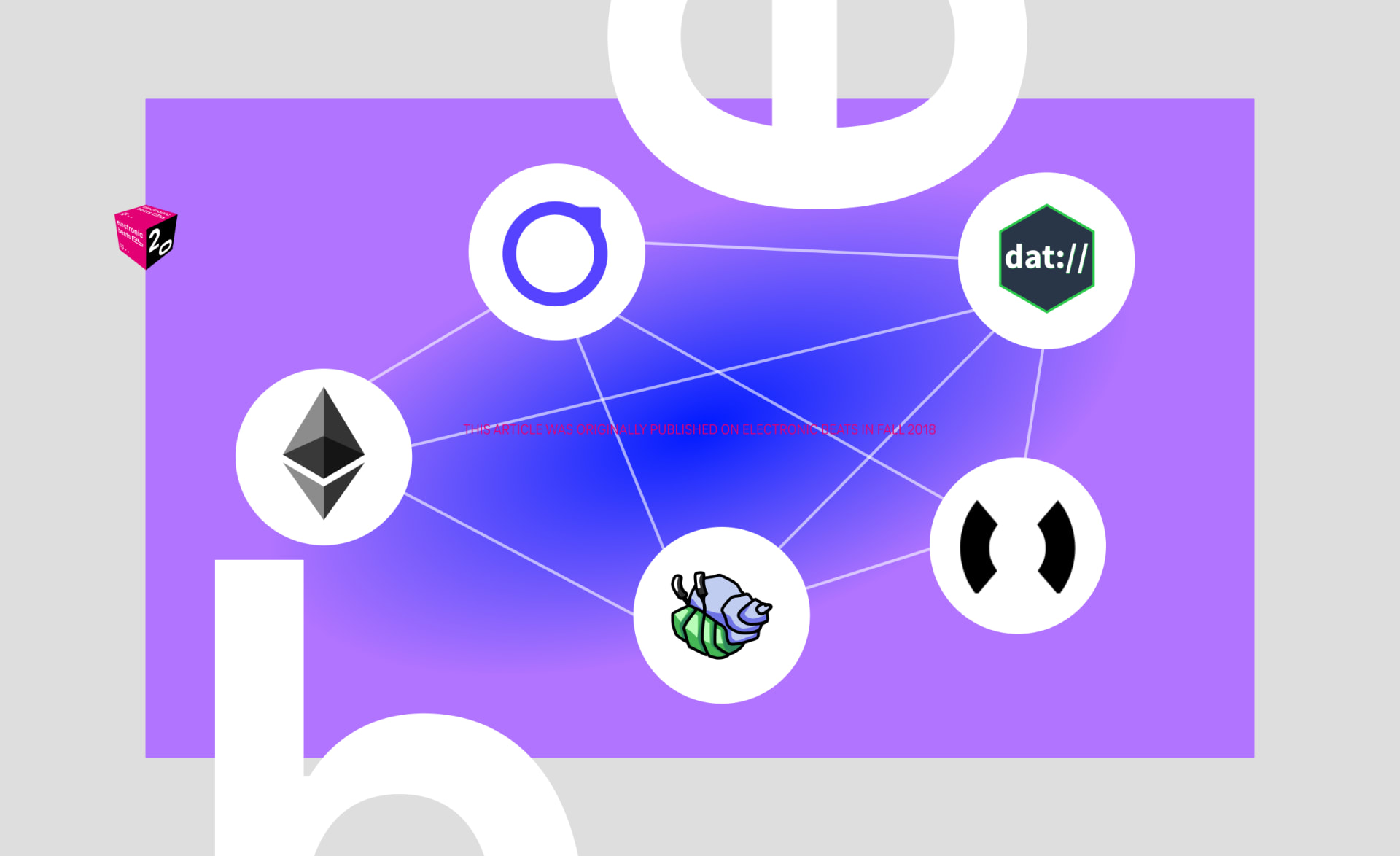

A Beginner’s Guide To The Decentralized Internet
The internet is evolving. Writer Lisa Blanning explores what decentralization could mean for the underground music community.
What comes after Google and other now-monolithic internet services? One answer could be in the so-called “decentralized internet”. A loose grouping of services and protocols, its aim is to redistribute online power to users and provide the possibility for collectivized ownership and censorship resistance. Though still in the early stages of its development, the ideas being developed in this direction could change the way we experience the internet in a way similar to the jump from web 1.0 to 2.0.
The scene surrounding the decentralized internet is connected in some ways to music—in Berlin, which has become a crypto hub, it can be seen via blockchain-powered music streaming service Resonate. Recently, the development of the decentralized internet has acquired an urgency in the face of the problems surrounding Facebook and Twitter over the course of the past two years. In an effort to introduce you to this new phenomenon, we tapped Telekom Electronic Beats collaborator Lisa Blanning to walk us through the basics. Considering the concept is complex, we’ve added links and videos throughout that will help you understand some of the ideas better.
(This article was originally published September 5, 2018.)
After almost three decades of the internet, many feel as though its initial utopian premise hasn’t exactly delivered. For those people, and anyone else fatigued by the current state of online, decentralization is an answer. While everyone is probably familiar with how peer-to-peer (or p2p) works in BitTorrent—and we can use that as the starting point for the current decentralization conversation—we’ve now entered the Bitcoin/crypto/blockchain era.
As such, decentralization as a topic is heating up. There’s a growing contingent of developers certain that decentralization is the future of the internet, which of course will affect culture as we know it, and is already its own growing subculture that dovetails with more familiar music subcultures.
To briefly explain decentralization, it’s a concept that can apply to lots of different things. For our purposes—to paraphrase Ethereum co-founder Vitalik Buterin from his 2017 Medium post—architectural decentralization (How many computers make up a system? How many of those can the system tolerate breaking down at any single time?) and political decentralization (How many individuals or organizations ultimately control the system?) are the most important applications.
At its core, blockchain is a distributed ledger where every computer on the network shares and verifies the same data. The ledger is immutable, meaning that it cannot be changed in the future. (If you need to learn more about blockchain, click here). So that’s architectural decentralization, and of course it currently leads the decentralization discussion. But really it’s the most visible of the many decentralized protocols, which also include IPFS (or InterPlanetary File System), SSB (or Secure Scuttlebutt) and Dat.
This element will show content from various video platforms.
If you load this Content, you accept cookies from external Media.
As Berlin-based p2p developer Louis Center—known within the Dat community as one of the contributors to p2p live streaming app Hypervision, currently working part-time at blockchain-compatible music streaming co-op Resonate—explains, “The Dat protocol is basically BitTorrent 2.0, but the fundamental difference is the data inside the archive can be changed over time. The IPFS protocol is attempting to rebuild the internet from scratch in a slightly different way. The idea is that we would have one file system for the entire internet, and people go to parts of the file system that they’re interested in.” Harry Lachenmayer—Boiler Room’s first full-time developer, now freelance in London and a p2p enthusiast—elaborates, “[IPFS] created a new standard for [web] addresses, for how to locate things even though we aren’t directly connected to the servers that are hosting them. And Dat allows you to communicate in real time without having to open an account anywhere or asking anyone for permission.”
This element will show content from various video platforms.
If you load this Content, you accept cookies from external Media.
As developers, both Center and Lachenmayer are more excited about Dat than IPFS. Partly, that’s down to its mutability, but also its inherent archive. Center clarifies, “Remember when Kanye put The Life of Pablo out and there were many variations over time? All those changes could be represented within a Dat archive. Releasing a record, you could continue to iterate it over time—those changes would be streamed out to anyone who’s connected to that Dat. And Dat archives are inherently versioned: you have the ability to only stream out the small changes that are made in the data, and you can keep a log of what has changed over time. Depending on the Dat client, you can save that data or throw it out. With Beaker browser [the open-source p2p web browser built on Dat], if you go to a Beaker URL and you add ‘+30’ on the end of it, you go to the 30th revision of that website. You’ve always got access to those iterations. If you want to see the 30th or the 50th or the 1st iteration of that website, you can always flip back to it.”
For an example of how that could change what we think of as a music release, I spoke with Luke Dubuis. While Dubuis has a day job as Resonate’s marketing director, he’s also part of the collective behind the Circadian Rhythms record label and long-running NTS Radio show. As a label, Circadian Rhythms makes a point of playing with formats: besides the usual vinyl and mp3s, they’ve also released a capsule clothing collection around a release, custom-designed bags and thrown parties raising awareness about air pollution featuring bespoke anti-pollution air masks.
Their next release will consist of a three-track EP by the artist Plata featuring a custom .plata wav file plus decoder, alongside a massive data dump of files hidden everywhere: on the “packaging” handed out on the radio show chat room, published on Dat, hiding in p2p files and hosted on torrents.
In terms of using something like Dat exclusively for a release, Dubuis is already cooking up an idea: “Forking sites is essentially downloading the content, duplicating it and being able to change it. My idea is to create a compilation by making a format on the p2p web, which could be image, text, audio. Give it to one artist and it could be the source material for their [contribution]. And then they could populate it with their own content, pass it on to the next artist, and that artist can fork it, and so on, and you end up with a mass body of work which is all connected. I think there’s a huge opportunity for remix culture and generally playing with things. It’s really interesting to be able to track the evolution of art.” While it’s true that you could use a similar concept for a compilation now, you’d eventually have to put out some kind of “finished” release. With Dat, the release can be durational, taking place over time, and with endless forking possibilities.
As Dubuis hints at, another thing that Dat, through Beaker, can do is simplify web publishing. As Center tells me, “The idea of Beaker is that users should be able to create new websites inside the browser itself, publish those directly to the network and users should be able to access those websites directly from the creator’s computer. And then redistribute those websites, as well. If there are 100 users on Beaker Browser at any time, they’re all distributing websites and files directly between each other rather than through a central web server—which is how most websites currently get served to users.”
While easy web publishing is possible via platforms like Tumblr or WordPress, one of the most important aspects of decentralization is political. Or as Center would put it, “The problem that we faced with web 2.0 was everybody decided to move to centralized platforms that granted them access to a space to publish their ideas at the expense of network autonomy: ‘You can publish to our servers and we will abstract away all of this complexity for you, to be able to get your new record out or your latest thinkpiece or whatever. But that has to happen on our terms. We’re essentially renting you the space.’ And that may be at the cost of putting advertising on your piece or charging you something, whatever. Tools like Beaker browser try to change that power dynamic: you can publish and put things on the network, even quicker than you would be able on a Medium page or Tumblr, but you have full control over it. And you’re distributing that website directly to other users. So you have full autonomy on the network. Which is the way that the power dynamic of the internet should work.”
This element will show content from various video platforms.
If you load this Content, you accept cookies from external Media.
If this chimes for anyone who’s read Nick Srnicek’s Platform Capitalism, the digital artist, researcher and teacher Mat Dryhurst—who is a vocal advocate for both platform awareness and decentralization—offers more nuance: “With some of the crypto stuff, what makes it interesting is the idea of censorship-resistance, which is a feature of decentralization. So the idea for journalists is that you could have a platform where it’d be impossible to take something down from the internet—I could see just as many people from the left arguing against that as for it. Similarly, data-protection. My biggest hope for crypto is that we can wean ourselves off the advertising industry. That, for me, is the big threat. That’s the one where I think, ‘This is fucked up, people can’t tell the difference between a genuine statement and a piece of promotion,’ and that’s a bigger problem than advertising. That will be the death of culture.”
While a political element is baked into the concept—check Karissa McKelvey’s keynote talk from the 2017 Full Stack Fest to get insight into the origins of Dat—all of the four p2p believers I spoke with share hopes beyond the internet. Whether it’s the traditional model of the co-op, like how Resonate operates, or the idea of a DAO (or decentralized autonomous organization, where every investor is able to vote anonymously instead of having a board of directors), political decentralization and the democratization of organizations, made easier through tech, is just as important.
This element will show content from various video platforms.
If you load this Content, you accept cookies from external Media.
Resonate’s CEO Peter Harris recently announced that he wants to be the first and last CEO of Resonate through decentralization and tokenization. Dubuis brings the story even closer to home: “Distributed ownership is the future. What happens when capital comes into cultural spaces and builds a platform off the back of all these creative people and then doesn’t give them ownership? The wider cultural pattern that we’re seeing is that it stops people’s imaginations to collectivize and build something. Pirate radio culture was built off collectivizing. People paid subs to be on the radio,” he says referring to the fees, or “subs”, paid by pirate radio DJs. “I paid subs to be on NTS [Radio]. I built the station through my contribution every month, to have my show. That’s how radio stations start. Platforms should be run and owned by everyone participating in them. NTS gave me and all their DJs options in the station. Now we’re all technically co-owners. A lot of stations won’t do that. That is part of what’s taught me about cooperative economics, about paying into something and having ownership of that. And these ideas are dying. We’re caught in a rinse repeat cycle of capital setting up platforms that exploit our creative output and giving us nothing in return. It’s not in their interest to be sustainable businesses because they all operate in order to be acquired. They eventually fail and we are forced to move into another shareholder economy. This cycle has to end!”
Similarly, Dryhurst is already thinking about variations on collectivized ownership: “The idea of group ownership or group equity is exciting. You go make a space, and you get a bunch of people to co-own it and run it, and you make that resilient for the next 30 years. And I think there are plenty of opportunities to. There’s some newer tech making that easier, like tokenization—once it’s fully legal in that respect. That won’t be long before that happens. If you care about something and you want it to stick around, own it. Traditionally, we’ve been told that if we want to support the culture with ownership, we ought to buy the record. But that is unrealistic, and those objects have not retained their monetary value within the culture. If you want to support the culture long term, we need to buy the building. Maybe we can’t afford to buy a building in London, but maybe we can elsewhere. And maybe the community that’s been putting on shows there for 20 years should run it and have equity in it. What is music but wanting to meet like-minded people? That’s what it is to me, it always has been. That value will not go out of fashion.”
Another driver of innovation is, as Dryhurst inherently understands, providing creative communities real space to meet and share ideas. In Berlin, the decentralized web community orbits around the Trust co-working and project space. Not only do they host p2p events, workshops, and talks (several organized by Center), they’re also a pub, or network node for both the Dat and SSB networks. Just as you’d expect, decentralized web has it own social network already. As Center describes, “SSB or Scuttlebutt is the protocol, then the main client that everybody uses on the SSB network is Patchwork—which is a social networking chat tool for posting updates, replying to other people, sharing things, just like you would on Facebook.”
This element will show content from various video platforms.
If you load this Content, you accept cookies from external Media.
For Lachenmayer, Scuttlebutt is attractive because “you don’t need permission from anyone to create new apps and tools that can interact with the network.” For Center, “The most interesting thing about SSB is the way in which you can connect to and share data directly with a user—literally from device to device. The most common way of finding another user on the Dat network is you have to go to an array of decentralized servers that sit everywhere and they basically keep track of everybody’s IP addresses. Whereas Scuttlebutt has no prior context of connecting two people over the internet. If you’re in the same space, if you’re in the same vicinity, if you’re on the same network—Wi-Fi network or devices all meshed together using bluetooth or something like this—then you will appear to the other user, and things can take place. I think this is a more interesting way of solving or talking about the scaling, discoverability issues. And it makes the focus of p2p more about offline networks that are completely separate to the internet. How they work, how they run, the people that revolve inside of those networks—because it actually maps to the way that creative communities work generally in real life.”
As such, while there’s been overlap between tech and music for as long as there’s been electronic music, in Berlin at least, the decentralization community feels at least partly related to the underground music community—not least because a good number of people participate in both. And in its own way, the decentralization community also feels like one of the most exciting subcultures currently going, a designation one might usually reserve for the latest club trends.
In the case of Dat, at least, that’s because it definitely is a community. As Lachenmayer explains,“The community is really what sets Dat apart from most other tech in this space. Most decentralized and blockchain stuff is shrouded in language that needs a computer science degree to untangle, and even then rarely makes any sense. Which is perfect for raising money, but in the end really doesn’t change anything.”
“The Dat and Scuttlebutt communities have a lot of people who really care about making it approachable and inclusive,” he continues. “Making this stuff work for people who aren’t already being perfectly served by current tools/systems is the key thing that will ultimately drive innovation.” And if the aims of the community succeed—network autonomy/independence, distributed ownership/governance and shared knowledge, to name a few—then it will be a community that’s worth following.
To experiment with the decentralized internet on your own, we recommend you download Beaker Browser.
Published March 19, 2021. Words by Lisa Blanning.












Follow @electronicbeats